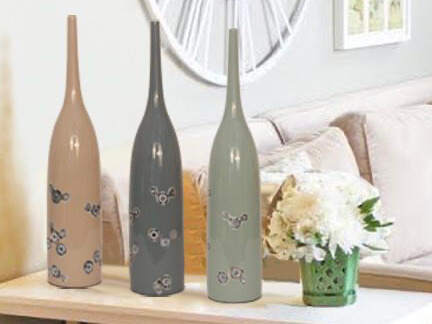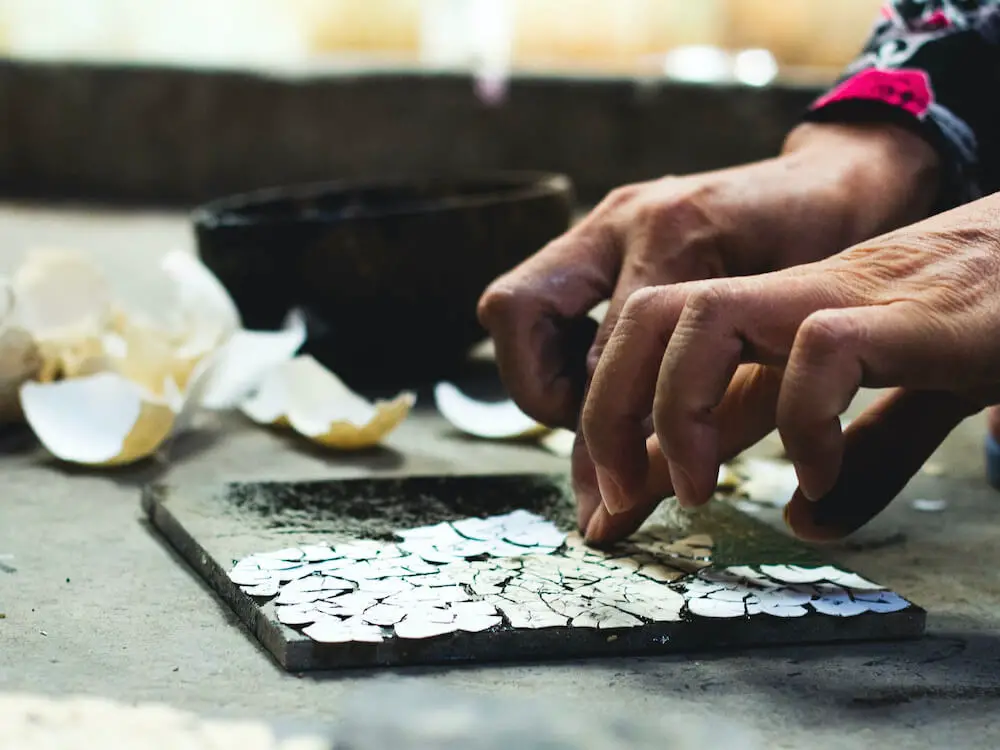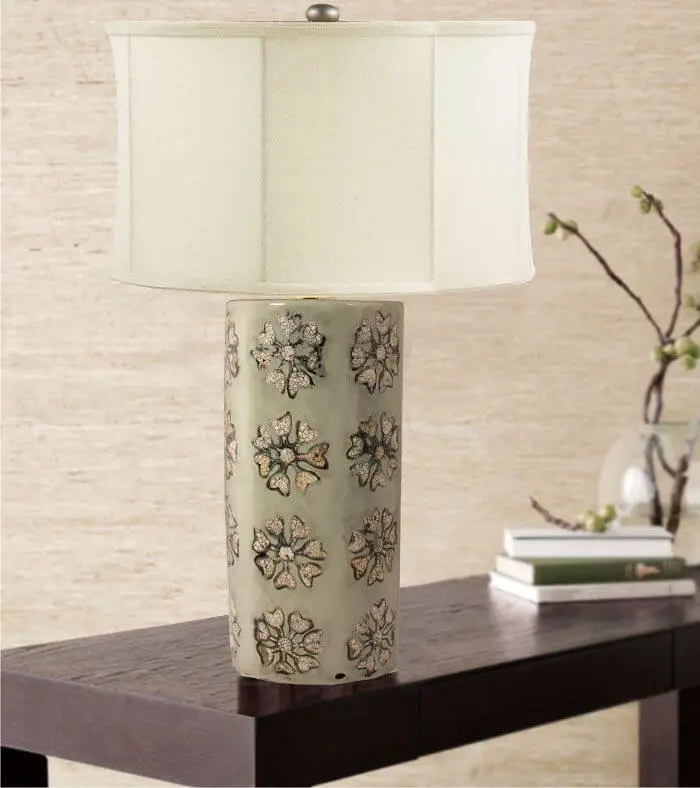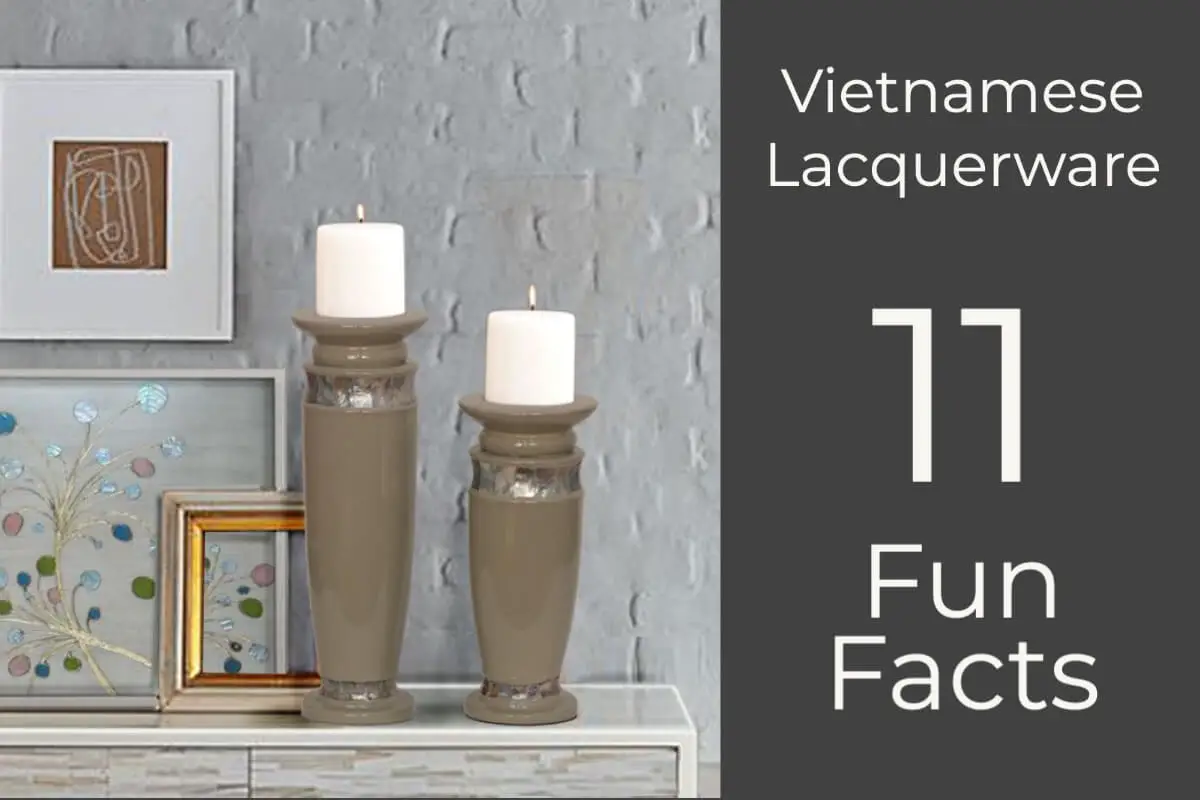One of the more famous handicrafts in Vietnam is lacquerware. Lacquerware is an ancient Vietnamese handicraft that Vietnam has produced for hundreds of years.
Vietnamese lacquerware is a paint process where lacquer paint is used to make lacquerware. This lacquer paint traditionally comes from the sap of the lacquer trees. The Vietnamese lacquerware has many layers; each must be carefully sanded, properly dried, and prepared. These layers help make Vietnamese lacquerware a unique art.
Table of Contents
- What Is Vietnamese Lacquerware?
- Top 11 Unknown Facts About Vietnamese Lacquerware
- 1 – Lacquerware Came From China
- 2- There Are Lacquer Trees
- 3 – Lacquer Is Extracted From The Trees
- 4 – Vietnamese Call Lacquer Sơn Mài.
- 5 – Lacquer Production Is Over 800 Years Old
- 6 – Families Pass Down The Lacquerware Skill
- 7- Vietnamese Lacquerware Changed Under Colonial French
- 8 – Real Lacquerware Has Many Layers
- 9 – Lacquerware Is A High-End Product
- 10 – Vietnam Produces Real Lacquerware
- 11 – Handle Lacquerware With Care
- Frequently Asked Questions
- Related Questions

What Is Vietnamese Lacquerware?
Vietnamese lacquerware is a lacquer painting technique that uses natural lacquer paint. Vietnamese lacquer requires many manufacturing steps in the lacquer production process, including making the base, preparing the lacquer base, and finally, applying the lacquer paint onto the surface.
Every lacquerware must be carefully sanded to ensure a smooth surface. Properly filing and drying between each step is one of the things that makes Vietnamese lacquerware so beautiful and unique.
Vietnamese lacquerware manufacturing is a handicraft skill that continues to be passed down from generation to generation; Vietnamese lacquerware is considered one of Vietnam’s traditional arts and crafts.
Top 11 Unknown Facts About Vietnamese Lacquerware
Vietnamese lacquerware involves a meticulous painting process using lacquer, traditionally derived from the sap of lacquer trees. Multiple layers characterize this distinctive art form, each requiring careful sanding, thorough drying, and precise preparation. The layered approach contributes to the uniqueness and artistry of Vietnamese lacquerware.
Here are 11 unknown facts about Vietnamese lacquerware
1 – Lacquerware Came From China
Vietnamese lacquerware came from China to Vietnam about 1,000 years ago; the Chinese ruled Vietnam for over 1,000 years. When the Chinese controlled Vietnam, they brought many of their handicrafts. Lacquerware is an example of one of the handicrafts the Chinese brought.
In ancient times, lacquerware was more functional than design-oriented. Lacquerware was used to coat furniture and pottery. and other household items to make them more durable; in time, Vietnamese lacquerware also began to take on an artistic quality
2- There Are Lacquer Trees
In Vietnam, lacquer is a natural product extracted from a tree known as a lacquer tree. The lacquer trees grow in Asia; in Vietnam, the lacquer tree grows in the northern part of Vietnam.
Lacquer trees are small-sized trees; they are not more than 3 to 4 meters (about 13 feet) in height, with a trunk size that is not very large. The trees are planted about 2 to 3 m apart from August through September.
3 – Lacquer Is Extracted From The Trees
The lacquer trees are tapped for their sap to produce traditional lacquer, similar to tapping a rubber tree to extract the rubber. The extracted lacquer sap is used to make the lacquer for Vietnamese lacquerware.
The sap will only come out of the lacquer trees during the early morning hours in June and July. The lacquer sap is then treated to remove excess moisture and any impurities.

4 – Vietnamese Call Lacquer Sơn Mài.
Vietnamese call Vietnamese lacquer Sơn Mài. Sơn is the Vietnamese word for painting, and Mài is for sanding. This is because Vietnamese lacquerware is about sanding and painting.
Even today, when you go to a lacquer factory, you can see the handwork of Vietnamese lacquerware production. There is a lot of hand sanding between each coat of lacquerware.
5 – Lacquer Production Is Over 800 Years Old
Many lacquer villages outside Hanoi have continually produced lacquerware for over 800 years. This means lacquerware is an ancient handicraft.
It also means that these villages have many skilled artisans who have grown up learning to refine their lacquerware skills.
6 – Families Pass Down The Lacquerware Skill
In the lacquer village, the families have passed down the lacquerware technique from generation to generation. This is because many families have been producing lacquerware for over 800 years.
It also means that the skills and techniques of lacquerware stay within the family.
7- Vietnamese Lacquerware Changed Under Colonial French
How did Vietnamese lacquerware produce significant change when Vietnam was a French colony? In the 1930s, the first Vietnamese painters studied at Ecole des Beaux-Arts or Indochina School of Fine Arts; these artisans discovered other materials to use with lacquer, such as eggshell, mother of pearl, bamboo, etc.
These artists also experimented with sanding techniques, gold and silver leafing, and eggshells to give their lacquer a new look and feel. This is why today, Vietnamese lacquerware is very different from lacquerware found in other parts of Asia.
8 – Real Lacquerware Has Many Layers
Vietnamese lacquerware has many layers, which are carefully hand-sanded between each layer. This is because lacquerware is genuinely a hand-made product.
Many of the lacquerware pieces have between 15 to 30 different finishing layers. Vietnamese lacquerware is a technique where a layer is built upon a layer. For example, the base could have more than 15 layers before applying any color or paint.

9 – Lacquerware Is A High-End Product
Lacquerware is a high-end home decor and home furnishing product. There are many reasons for this, but due to the many layers of the lacquer, we can achieve some very complicated and sophisticated finishes that we can not perform any other way.
10 – Vietnam Produces Real Lacquerware
There is a lot of fake lacquerware on the market, but Vietnam produces real lacquerware. China factories may produce lacquer that they tried to imitate the Vietnamese lacquer by spraying paint and a high gloss finish, but this is not true lacquerware.
At Mondoro, all the lacquerware we produce is authentic Vietnamese lacquer. We use authentic lacquerware to achieve the best look and feel possible.
11 – Handle Lacquerware With Care
Even though lacquerware is highly durable, you should handle it carefully like any high-end product. To clean a lacquerware surface, use mild soap and water and wipe it with a damp cloth; dishwashing soap is always an excellent mild soap.
Vietnamese lacquerware is a beautiful finish and product. It is not only an ancient Vietnamese handicraft that highly skilled artisans produce, but it also has a beautiful look and feel you can only achieve through lacquerware manufacturing.
If you are interested in finding out more about Vietnamese lacquerware and how Mondoro can help you create, develop, and manufacture great home decor and home furniture products, including Vietnamese lacquerware, please get in touch with me, Anita, at my email by clicking here.
Find out more about how Mondoro can help you create, develop, and manufacture excellent home decor and furniture products – don’t hesitate to contact me, Anita. Check out my email by clicking here or become a part of our community and join our newsletter by clicking here.
Mondoro gives out a FREE Lookbook to anyone interested. You can receive a copy of our latest Lookbook by clicking here.
Listen to our Podcast called Mondoro Company Limited. You can find it on all major podcast platforms. Try out to listen to one of our podcasts by clicking here.
Subscribe to our Mondoro Company Limited YouTube Channel filled with great videos and information by clicking here.
Frequently Asked Questions
What is Vietnamese lacquerware?
Vietnamese lacquerware refers to a traditional art form where lacquer paint, derived from the sap of lacquer trees, is applied to create intricate and decorative designs on various objects.
How is lacquer paint obtained from lacquer trees?
Lacquer paint is obtained by tapping the lacquer trees, which involves making incisions in the bark and collecting the sap. This sap is then processed to create the lacquer used for painting.
What makes Vietnamese lacquerware unique?
Vietnamese lacquerware is known for its distinctive layers. Each layer is meticulously applied, sanded, dried, and prepared, resulting in a smooth and glossy finish. This layering technique gives Vietnamese lacquerware its unique and luxurious appearance.
What types of objects are commonly made using Vietnamese lacquerware?
Vietnamese lacquerware can be used to create a wide range of objects, including bowls, vases, plates, boxes, trays, furniture, jewelry, and decorative art pieces.
Is Vietnamese lacquerware purely decorative, or can it be functional as well?
Vietnamese lacquerware can serve both decorative and functional purposes. While some pieces are designed primarily for display, others, such as bowls or trays, can be used for serving food or holding everyday objects.
How long does it take to create a piece of Vietnamese lacquerware?
The time required to create a piece of Vietnamese lacquerware can vary depending on its complexity, size, and the number of layers applied. It can take anywhere from several days to several weeks or even months to complete a single piece.
What are the materials used in Vietnamese lacquerware?
The primary material used in Vietnamese lacquerware is lacquer paint derived from the sap of lacquer trees. Other materials such as wood, bamboo, or metal may be used as the base for the objects.
Are there specific techniques or styles associated with Vietnamese lacquerware?
Vietnamese lacquerware encompasses a variety of techniques and styles. Some common techniques include incised lacquer, eggshell inlay, mother-of-pearl inlay, and painted lacquer. Different regions in Vietnam may have their own distinctive styles and motifs.
Related Questions
How to Manufacture Vietnamese Lacquerware?
Vietnamese lacquer requires many manufacturing steps in the lacquer production process, including making the base, then preparing the lacquer base to be applied, to finally applying the lacquer paint onto the surface. Every piece must be carefully sanded to give it a very smooth surface. Vietnamese lacquerware production requires a lot of skill and knowledge.
To learn more, you can read How to Manufacture Vietnamese Lacquerware? An Insider’s Guide to Lacquer by clicking here.
Why Is It Called Mother Of Pearl?
The name mother used in Mother of Pearl is thought to come from a nearly obsolete meaning of mother, which means “scrum, drugs or leftover fifth.” This would be because the Mother of Pearl comes from the leftover shell of the oyster, clam, or mussel. The scientific name for Mother Of Pearl is nacre.
You can discover more about Why Is It Called Mother Of Pearl? Pearls and Mother of Pearls by clicking here.


